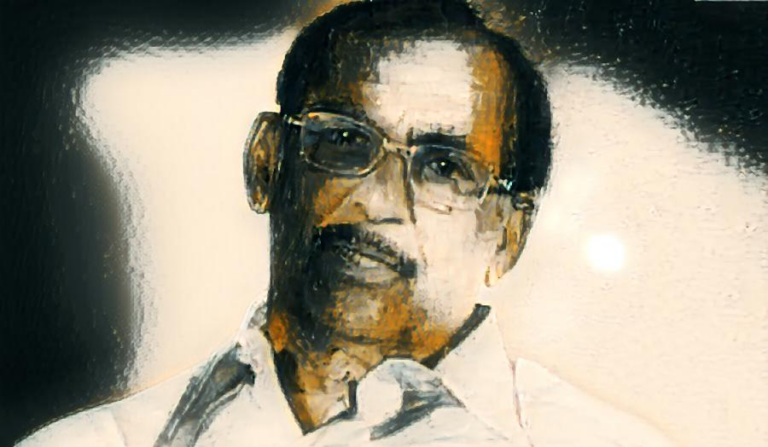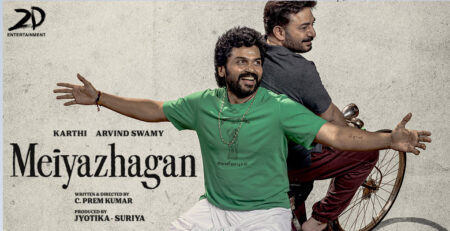He was no run-of-the-mill filmmaker. Velayudhan Nair, aka Crossbelt Mani who died on October 30 made movies that marked an era of unabashed openness in Malayalam cinema.
Talking about the need to polish the mirror of our memories, Milan Kundera says, “Remembering our past, carrying it around with us always, maybe the necessary requirement for maintaining, as they say, the wholeness of the self.”
Adds Kundera in Identity: “To ensure that the self doesn’t shrink, to see that it holds on to its volume, memories have to be watered like potted flowers, and the watering calls for regular contact with the witnesses of the past, that is to say, with friends. They are our mirror; our memory; we ask nothing of them but that they polish the mirror from time to time so we can look at ourselves in it.”
What Kundera says about friends is also true for cinema — the mirror of the 21st Century. For individuals and society at large, movies have an afterlife only if the silver screen mirror is polished from time to time. Such willingness to polish memory and remember is a state of mind and an attitude towards history and the past that made us what we are.
In the case of Malayalam cinema, memories at the most extend back to only one or two decades, barring a few superhits or sensational ones that linger in public memory and media for another decade or so. As years roll by, and more and more films flicker past, the older ones fade away from the limelight. They are forgotten and merge into the void called oblivion or History.
Fading out
Take, for instance, Prem Nazir, one of the most glamorous evergreen heroes and superstars who reigned over the film scene in the 1960s and 70s. Who remembers him now? If at all he flickers before our eyes and in our minds, it is mostly in some nostalgic film song programme or when some mimicry artist imitates his gestures and dialogues. When have we had a decent retrospective of his films? Is there a comprehensive biography on this great actor and star? If at all we commemorate him, in what form and tone is it? As a fading Black & White photograph from the past? An image that invokes some faraway lands, long-ago feelings? A nostalgic memory from a certain period in your life?
Cinema in the celluloid era always had the problem of being forgotten once its prints fade out and get scratched and torn after a certain number of screenings. Unless new prints are taken from the negative, they run out of circulation and also from public memory; only a very few films manage to survive and take re-births in new prints. Actually, in every language and film industry, it was popular media like television that gave a new lease of life to cinema through telecast of old classics and popular hits.
But in the case of Malayalam, the Black & White films seem to be anathema to our channels; among the thousands of B&W films made in the language, only a minuscule are ever shown in privately owned channels. The old films had a better and longer life through VHS format (mostly due to the demand from Malayalee migrants in the Gulf) and later through CD/DVD technologies when it became easy to copy and share. At present, it is actually YouTube that functions as the virtual historical archive of Malayalam cinema.
Singing in the gain
Interestingly, more than the films themselves, it is the film songs that have always had longer and more accomplished afterlives. And it is through the songs that many of the films, auteurs and actors of earlier eras are remembered and revered. In Indian cinema, voices always had longer lives than images, with the exception of a few stars.
Though most of the movies (especially of the B & W period) have been lost and forgotten, the songs in them were immortalized by the singers, lyricists and music directors of the period who still continue to inspire young, upcoming singers as well as music lovers. Television channels and their umpteen reality shows and music programmes have contributed to their longevity and persistence in public memory.
Even a cursory glance at the viewership data in Youtube for the songs and their respective films will substantiate this point further. Along with the memories about the films, memories about the people who worked in and for it – especially those who worked behind – also fade.
So, when someone like Crossbelt Mani (K Velayudhan Nair 1935-2021) departs, it is always a second demise. All the cine-artists of the earlier era first die when their career comes to a close, and again when they meet with their physical death. In cinema, barring the select and lucky few, remembrance about people who belong to the previous generations lingers only for a few more years before it is swamped out of public view and memory by the rise of new trends, stars and hits.
Velayudhan Nair, who came to be known as Crossbelt Mani owes his surname to one of the most successful films he made in 1970 titled Cross Belt.In a career spanning more than two decades, he directed around 40 films apart from working in many as a cinematographer. Some of his important works include his debut film Midumidukki (1968), Cross Belt (1970), Naadan Premam (1972)Kaapalika (1973), Chottanikkara Amma (1976), and Devadas (1989).
Most of his early films were based on literary works and scripts of eminent writers such as SK Pottekkatt, Thoppil Bhasi, Kakkanadan, NN Pillai, etc. He was also known for his penchant for action scenes, and many of his films have action sequences that have been innovative in terms of their choreography, editing and picturisation.
Like many other important filmmakers of his period, it is the many unforgettable songs from his early films that still commemorate Mani’s oeuvre. Here are some of them: Akale Akale Neelakaasham, Ponnum Tharivala Minnum Kayyil, (Midumidukki), Kaalam Maari Varum, (Cross Belt), Sarapancharam pushpa sarapancharam (Kaapalika) Chandrika Charchithamam (Putrakameshti), Manasu Manasinte Kathil (Chottanikara Amma), Pularkalam (Neethi Peedam), Swapnamalini Theerathundoru (Devadas).

Bold narratives
One cannot call Mani an auteur with a personal signature and distinct style of his own, but he was a filmmaker who was more concerned about making films that entertain a mass audience. But many of his early films are deeply influenced by the social-realist aesthetic of the period, along with the deep influence of literature; his literary interests persisted even late into his career as is evident in the adaptation of the Saratchandra Chatterjee classic Devdas in Malayalam in 1989, starring none other than Venu Nagavalli, the eternal Devdas of Malayalam cinema.
Thematically, many of his early films dealt with conflicts within the family (what we now call toxic patriarchy or masculinity), and issues relating to sexual transgressions. Significantly, he has portrayed some of the very bold female characters in his films.
In Midumidukki, we see the desperate struggle of an independent and working woman (played by Sarada) who runs her family against lecherous and morally weak men; while her brother-in-law tries to sexually exploit and emotionally blackmail her into it, her lover (Sathyan) too is caught in the devious web of morality; he is not courageous enough to live up to her love. In the end, she rejects all the men in her life, the flirt, lover and the lech, by putting an end to her life. It is too late when the men realize her worth or intentions.
Cross Belt is an even more daring film. Based on a very successful play by NN Pillai, it is a crime thriller that unfolds during the course of a day and night. The film starkly brings to the fore the constant harassment women face at work (in a tile factory) and outside. It is an investigative story, family drama, and a trenchant political critique all rolled into one.
What drives the heroine (again played by Sarada) into a life of poverty and struggle is not just economic factors, but also the betrayal of political parties and movements: her parents were idealist political activists once; while her father is bed-ridden due to police torture, the mother is insane.
As the investigation progresses, it also turns into an ethical fight between upright and corrupt elements in the system. Deep conflicts within all these establishments – the family, politics/parties and police/government – that constitute the internal drama of the movie, are brought to life by the acerbic and stinging dialogues penned by NN Pillai. Retrospectively, Cross Belt is also a ‘new-gen movie – where time is compressed and running out, with all the twists and turns, situations and characters woven into a tight narrative framework.
Another landmark film is Kaapalika, one of the rare films in Malayalam that explicitly deals with the institution of prostitution (there is a word play with these words in the movie itself). Based on NN Pillai play, the film portrays Kaapalika, a middle-aged woman (Sheela) who runs a high-end brothel in Bombay.
The film begins with the image of Buddha’s face being caressed by Sheela, a striking visual juxtaposition with a very evocative title song written by NN Pillai himself about the ‘viswaroopam’ of truth where the gentle breeze and violent storm, searing desert and forest of sexual desires mix and blend in the epitome of love, Kaapalika who sees the god of love even in the yogi of Kapilavastu.
The first half of the film is set in Bombay and introduces an array of characters – a namesake husband who acts as Kaapalika’s servant, a housewife who works for Kaapalika to make extra money, her executive husband who acts as a pimp for his company and eventually for his wife, the priest who seeks donation for his orphanage, the young man who wants to settle his accounts at the brothel before going home to marry etc.
Talking women
There are also some very interesting shots of the city at night and of the red streets (Grant Road) in this part. In the second half, the scene shifts to Rosamma’s (Kaapalika’s original name) house in Kerala, where preparations for her sister’s marriage is underway. Though the milieu shifts from the metropolitan city of Bombay to a village in Kerala, from Kaapalika’s urban brothel to her family back home, what remains unchanged are the patriarchal values and sexual exploitation of women.
Very rarely has a Malayalam movie discussed so openly and searingly about the lies upon which the institutions of family and marriage are founded, illusions about monogamy, hypocrisy underlying sexual morality, ‘wages of sin’ that flow into charity, etc. All the three films mentioned above have women, their desires, struggles and resistance at the centre of the narrative. It was also a period when the most successful male stars such as Sathyan, Prem Nazir, Kottarakkara or Ummer had no problems playing supporting and even submissive roles.
For them, roles and characters were more important than stardom and glitz. It was also a period when stories and directors were more important than stars and television ratings. One important trait of directors of that generation such as Mani was that despite all their commercial tastes and packaging, they were committed to the story and the audience, rather than the star (read male star) and their fans.
Many of the themes, treatment styles and narrative modes that are celebrated now as ‘the contemporary’ and ‘new-gen’ could be found in the films of filmmakers of that generation such as Mani. Only that we have to polish the dust of the contemporary to see our own reflections and its lineages more clearly and closely.




